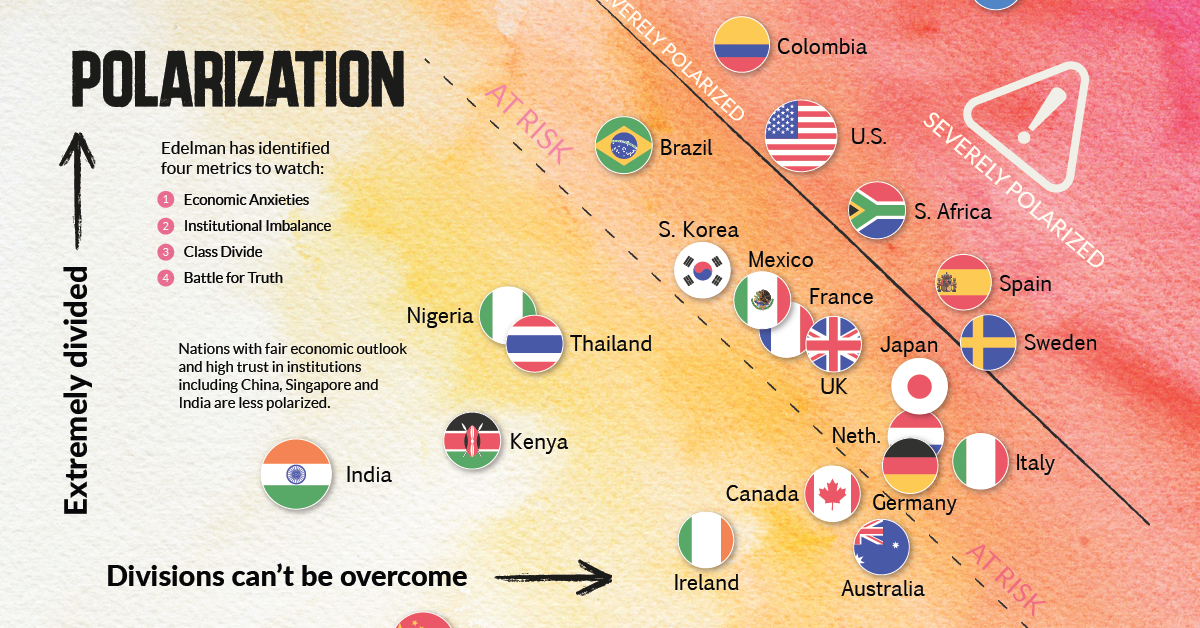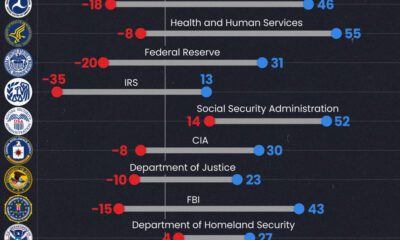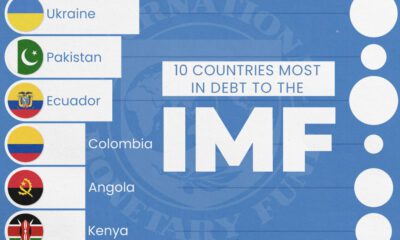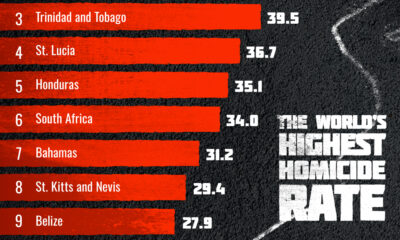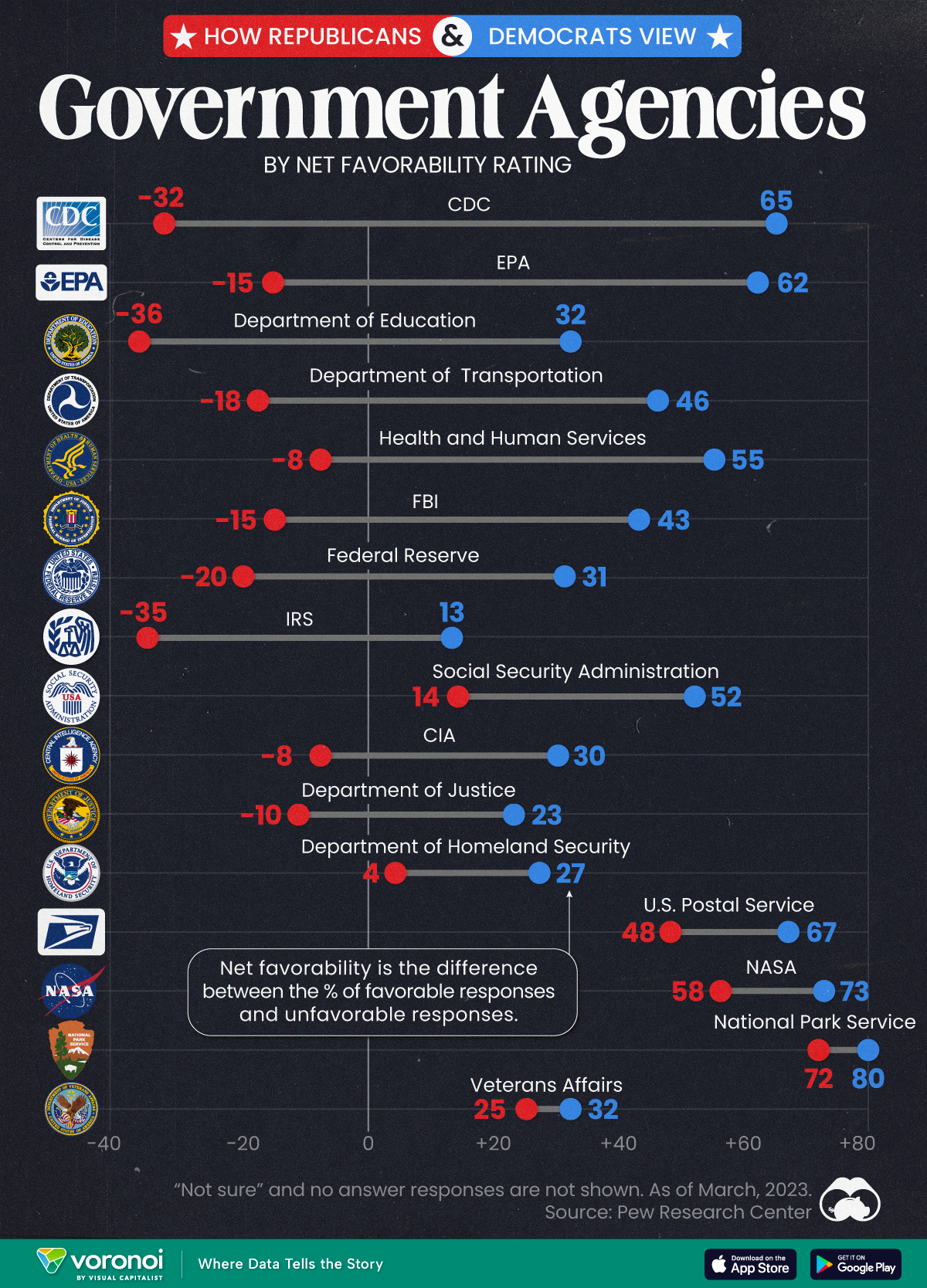Politics
Which Countries are the Most Polarized?
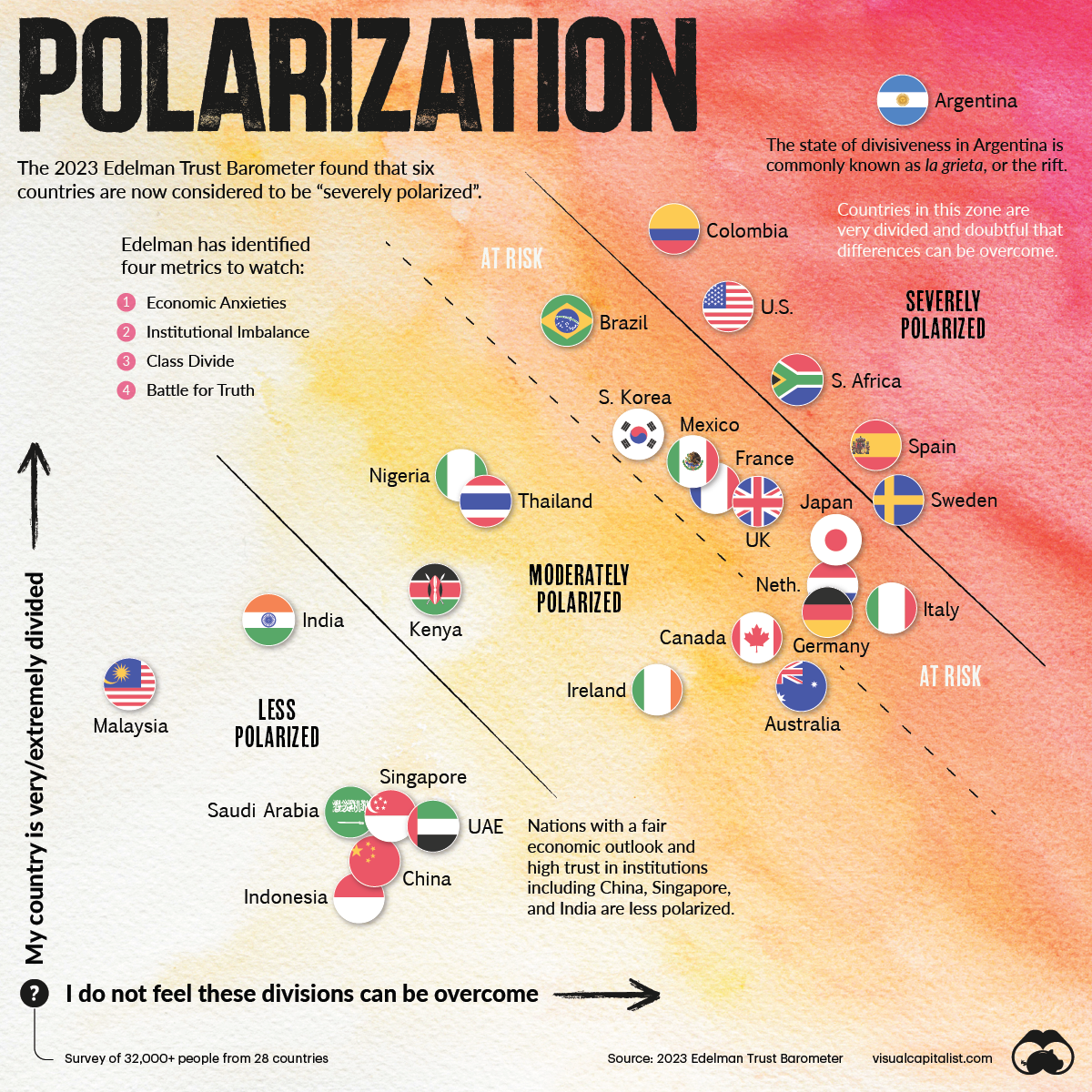
Which Countries are the Most Polarized?
How do you measure something that’s made headlines for half a decade but is still difficult to quantify? We’re talking about polarization.
Even within the social sciences, polarization covers everything from racial segregation, to labor skill levels, to class divide, to political ideology.
How Do You Quantify Polarization?
Edelman’s data on which countries are the most polarized comes from survey results asking respondents two very simple questions:
- How divided is their country?
- How entrenched is the divide?
The questions help bring to light the social issues a particular country is facing and the lack of consensus on those issues.
Plotted against each other, a chart emerges. A country in the top–right corner of the chart is “severely polarized.” Countries located closer to the lower–left are considered less polarized.
In the report, Edelman identifies four metrics to watch for and measure which help quantify polarization.
| Economic Anxieties | Will my family be better off in five years? |
| Institutional Imbalance | Government is viewed as unethical and incompetent. |
| Class Divide | People with higher incomes have a higher trust in institutions. |
| Battle for Truth | Echo chambers, and a low trust in media. |
Following Edelman’s metrics, countries with economic uncertainty and inequality as well as institutional distrust are more likely to be polarized. Below, we look at key highlights from the chart.
Severely Polarized Countries
Despite being one of the largest economies in Latin America, Argentina is the most polarized country surveyed by a large margin. Foreign loan defaults, a high fiscal deficit, and now surging inflation have created a perfect storm in the country.
43% of the Argentinian respondents said they will be better off in five years, down 17 percentage points from last year.
Along with fiscal upheaval, Argentinians are also dealing with enduring corruption in the public sector and abrupt policy reversals between governments. Only 20% of those surveyed in Argentina said they trusted the government—the least of all surveyed countries.
Here are all six of the countries considered to be severely polarized:
-
🇦🇷 Argentina
🇨🇴 Colombia
🇺🇸 United States
🇿🇦 South Africa
🇪🇸 Spain
🇸🇪 Sweden
In the U.S., heightened political upheaval between Democrats and Republicans over the last few years has led to strengthening ideological stances and to an abundance of headlines about polarization. Only 42% of respondents in the country trust the government.
And in South Africa, persistent inequality and falling trust in the African National Congress also check off Edelman’s metrics. It’s also second after Argentina with the least trust in government (22%) per the survey.
Moderately Polarized Countries
The biggest cluster of 15 countries are in moderately polarized section of the chart, with all continents represented.
-
🇧🇷 Brazil
🇰🇷 South Korea
🇲🇽 Mexico
🇫🇷 France
🇬🇧 United Kingdom
🇯🇵 Japan
🇳🇱 Netherlands
🇮🇹 Italy
🇩🇪 Germany
🇳🇬 Nigeria
🇹🇭 Thailand
🇰🇪 Kenya
🇨🇦 Canada
🇦🇺 Australia
🇮🇪 Ireland
Some are on the cusp of being severely polarized, including economic heavyweights like Japan, the UK, France, and Germany. On the other hand, smaller economies like Thailand, Kenya, and Nigeria, are doing comparatively better on the polarization chart.
Less Polarized Countries
Countries with fair economic outlook and high trust in institutions including China, Singapore, and India are in the bottom left sector of the chart.
-
🇮🇩 Indonesia
🇨🇳 China
🇦🇪 United Arab Emirates
🇸🇬 Singapore
🇸🇦 Saudi Arabia
🇲🇾 Malaysia
🇮🇳 India
It’s interesting to note that of the seven countries in that sector, three are not democracies. That said, there are also more developing countries on this list as well, which could also be a factor.
Looking Ahead
Edelman notes that polarization is both “cause and consequence of distrust,” creating a self-fulfilling cycle. Aside from the four metrics stated above, concerns about the erosion of civility and weakening social fabric also lead to polarization.
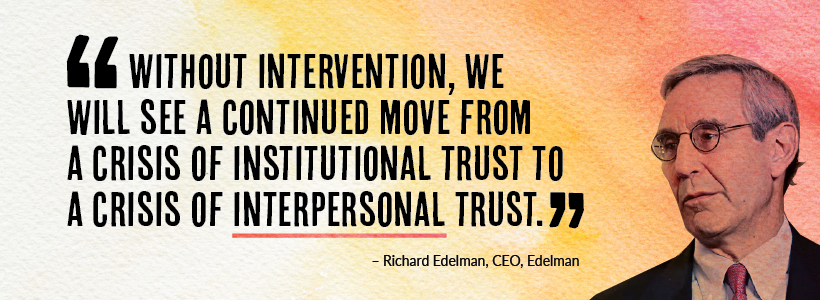
As global events unfold in 2023—including looming worries of a recession—it will be fascinating to see how countries might switch positions in the year to come.
Where does this data come from?
Source: The 2023 Edelman Trust Barometer
Data note: Survey conducted: Nov 1 – Nov 28, 2022. Survey included 32,000+ respondents in 28 countries. Russia was omitted from this year’s survey. See page 2 of the report for more details.
Public Opinion
Charted: How Democrats and Republicans View Government Agencies
Predictably, results diverge when both Democrats and Republicans are asked to rate key government agencies in the United States.

How Democrats and Republicans View Government Agencies
This was originally posted on our Voronoi app. Download the app for free on iOS or Android and discover incredible data-driven charts from a variety of trusted sources.
Forget the presidential race, the partisan divide in America can also be seen by how Democrats and Republicans feel about key government agencies.
We visualize the net favorability ratings of 16 federal government agencies, based on respondent party affiliation.
To find this data, Pew Research Center surveyed more than 10,000 adults, between March 13-19, 2023. View their methodology page for more details about the survey, the questions asked, and the results obtained.
Republicans Don’t Like How the CDC Handled the Pandemic
The division in net favorability is deepest for three federal government agencies. While the CDC garnered a net favorability rating of 65 from Democrats, more Republicans rated the agency unfavorably, leading to a net favorability rating of -32.
Similarly, with the EPA and the Department of Education, the difference in net favorability between the two voting sides is as high as 70–80 points.
| Federal Agency | Republican Net Favorability Rating | Democrat Net Favorability Rating |
|---|---|---|
| 🔬 CDC | -32 | 65 |
| 🌿 EPA | -15 | 62 |
| 📚 Department of Education | -36 | 32 |
| 🚗 Department of Transportation | -18 | 46 |
| 💉 Health and Humans Services | -8 | 55 |
| 💰 Federal Reserve | -20 | 31 |
| 🕵️ FBI | -15 | 43 |
| 💼 IRS | -35 | 13 |
| 💼 Social Security Admin | 14 | 52 |
| 🕵️♂️ CIA | -8 | 30 |
| ⚖️ Justice Department | -10 | 23 |
| 🛡️ Homeland Security | 4 | 27 |
| 📮 USPS | 48 | 67 |
| 🚀 NASA | 58 | 73 |
| 🏞️ Park Service | 72 | 80 |
| 🎖️ Veterans Affairs | 25 | 32 |
Pew Research Center notes that Republicans didn’t always view the CDC quite so unfavorably, though a direct comparison is impossible.
Nevertheless, per the source, in March 2020, 84% of surveyed Republicans expressed positive views of the CDC’s performance. By October 2022, just 32% said the CDC had done an excellent or good job of handling the pandemic.
Meanwhile, there are a few agencies the two sides do agree on: the National Park Service, the Postal Service, and NASA.
And they both agree on Veterans Affairs as well: though neither share a particularly high opinion of the organization.
Finally, Democrats consistently rate all sixteen agencies on the survey more favorably than Republicans, showing consistency about how each side views the government in general.
-

 Maps7 days ago
Maps7 days agoMapped: Southeast Asia’s GDP Per Capita, by Country
-

 Markets2 weeks ago
Markets2 weeks agoVisualizing Global Inflation Forecasts (2024-2026)
-

 United States2 weeks ago
United States2 weeks agoCharted: What Southeast Asia Thinks About China & the U.S.
-

 United States2 weeks ago
United States2 weeks agoThe Evolution of U.S. Beer Logos
-

 Healthcare1 week ago
Healthcare1 week agoWhat Causes Preventable Child Deaths?
-

 Energy1 week ago
Energy1 week agoWho’s Building the Most Solar Energy?
-

 Markets1 week ago
Markets1 week agoMapped: The Most Valuable Company in Each Southeast Asian Country
-

 Technology1 week ago
Technology1 week agoMapped: The Number of AI Startups By Country




